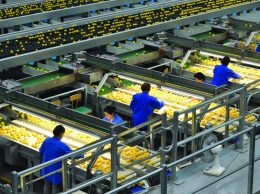Op/ed: Central planning still rules China’s economy
By David Newton on October 18, 2013
BEIJING — Innovation (“Gexin” in Mandarin) is one of the four pillars of Chinese society — championed alongside Patriotism, Inclusiveness, and Virtue. But does innovation really function in a communist state-controlled economy that only partially incorporates a few facets of free-market capitalism?
China does not develop true “Gexin.” Chinese education values rote memory (math and science formulas — facts and figures), but doesn’t foster critical thinking and creativity. There’s no framework within which to pursue real innovation, no profit incentive to introduce it, and because of inadequate rule-of-law, no way to protect intellectual property once it would be implemented.
In America, entrepreneurial business failure is considered great experience — a notch in one’s belt and preparation for the next new venture idea. But in China, it’s paramount to losing face — a one-time personal disgrace from which there’s no rebound.
As such, the Chinese industrial, wholesale, and retail firms simply replicate (knock-off) products and services innovated outside the country. Add in pervasive state controls, and this hybrid economy is positioned only to follow, never to lead. Quick examples on my trip were: AMBERcrombie t-shirts, unofficial Disney characters promoting every type of product, dozens of iPod and iPad look-alikes, and Sketchers work-out sneakers (not just for portrait artists). It continues with my 4-star hotel’s television, hairdryer, mini-fridge, phone, lamps, and restaurant room-key sign-in running in Windows 95 on a circa-1997 Packard-Bell PC. The same “Gexin” lag defines most Chinese factories, with labor-intensive assembly lines. But when it comes to critical hi-tech in medical, IT, aviation, and communications, the Chinese replicants always step aside for the true innovation born in — and delivered by — American, Japanese or European firms.
Communist central planning with a capitalism façade is why with over 50 million people living in Shanghai and Beijing combined, less than 6 percent work in the private sector. China has over four times the U.S. population, but GDP is $8.5 trillion — about half the American economy. The Apple mega-retail stores are jammed with hundreds of shoppers, but the iPhone 5C costs around 6,000RMB or $1,000) — more than half a typical middle-classer’s monthly pay. Beijing “boasts” 4 million cars for its 22 million residents — but still has 9.5 million bicycles and 2.4 million scooters, while Los Angeles has more automobiles (5.3 million) than people (4 million). Riding the Shanghai Hongqiao bullet train to Beijing in first class is smooth and quiet at 304 km/hour — and only $110. But the included “meal” is a foam tray of generic rice, wilted veggies, a bag of popcorn, and an artificial-orange drink. And outside, for almost four hours straight, the view is nothing but small farms and tiny rural hamlets right out of the 1940s.
China Central Television is the monopoly programming provider, so it seems a fitting irony that “CCTV” controls both what citizens watch, and watching its citizens. Alongside campy Mandarin rappers, a “Voice” knock-off talent show, and MTV China, state-run TV still dedicates three channels to Mao-suited and military-uniformed talking heads mundanely reading the crop report, gains in factory workers’ output, and skyscraper construction updates to prove centrally-planned economic efficiency. Just 25 percent of the population is middle class — but that’s 320 million people, larger than all the U.S.
One million shoppers walk along Nanjing Road’s 900-plus retail stores in Shanghai — in a single day. But a state-run strategy monopolizes the credit-debit card business. Forget using your Visa here. The only plastic accepted is UnionPay for Chinese residents, so visitors pay with cash for virtually everything. It’s estimated this keeps $300 billion of annual consumer transactions exclusively within China’s banks. The World Bank reports average annual GDP growth between 7.5 percent and 12 percent since 2004. But this belies the role of private enterprise, as state-run companies consistently drive 85 percent of GDP growth, while the private sector has experienced less than 2 percent annual growth since 2000.
The new Shanghai Free-Trade Zone opened in late September — but why does China need to showcase a zone set aside for free trade? And why are Hong Kong/Shenzhen called “semi-autonomous” regions, even as China Shipbuilding, Ltd. is now raising $1.4 billion from the global private capital markets to finance the next five years of the state-PRC’s warship production? The bottom line is that China flirts with free market capitalism only as much or as little as needed to serve the goals of the state. Central planning still calls the shots.
• Former Westmont College professor David Newton is a new venture consultant, author and adjunct professor with The Rady School of Management at UC San Diego and the Pepperdine MBA programs. He is traveling through Asia this fall.











